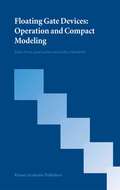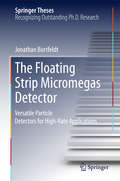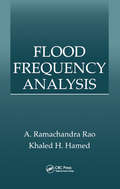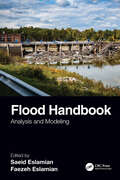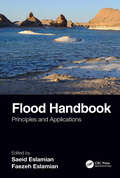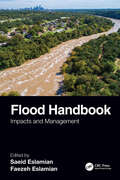- Table View
- List View
Floating, Flowing, Flying: Pieter J. Zandbergen’s Life as Innovator, Inspirator and Instigator in Numerical Fluid Dynamics
by D. Dijkstra Marek Kierstan Hans Kuerten H. K. KuikenThis book is dedicated to Pieter J. Zandbergen on the occasion of his sixty-fifth birthday. It contains fourteen original contributions written by specialized authors and deals with the application of mathematics and numerical analysis to a wide variety of problems in fluid dynamics and related fields. At present the research field of computational fluid dynamics is growing strongly and the book is therefore of interest to applied mathematicians, theoretical physicists and engineers.
Floating Gate Devices: Operation and Compact Modeling
by Paolo Pavan Luca Larcher Andrea MarmiroliFloating Gate Devices: Operation and Compact Modeling focuses on standard operations and compact modeling of memory devices based on Floating Gate architecture. Floating Gate devices are the building blocks of Flash, EPROM, EEPROM memories. Flash memories, which are the most versatile nonvolatile memories, are widely used to store code (BIOS, Communication protocol, Identification code,) and data (solid-state Hard Disks, Flash cards for digital cameras,). The reader, who deals with Floating Gate memory devices at different levels - from test-structures to complex circuit design - will find an essential explanation on device physics and technology, and also circuit issues which must be fully understood while developing a new device. Device engineers will use this book to find simplified models to design new process steps or new architectures. Circuit designers will find the basic theory to understand the use of compact models to validate circuits against process variations and to evaluate the impact of parameter variations on circuit performances. Floating Gate Devices: Operation and Compact Modeling is meant to be a basic tool for designing the next generation of memory devices based on FG technologies.
Floating Offshore Wind Energy: The Next Generation of Wind Energy (Green Energy and Technology)
by Joao Cruz Mairead AtchesonThis book provides a state-of-the-art review of floating offshore wind turbines (FOWT). It offers developers a global perspective on floating offshore wind energy conversion technology, documenting the key challenges and practical solutions that this new industry has found to date. Drawing on a wide network of experts, it reviews the conception, early design stages, load & structural analysis and the construction of FOWT. It also presents and discusses data from pioneering projects. Written by experienced professionals from a mix of academia and industry, the content is both practical and visionary. As one of the first titles dedicated to FOWT, it is a must-have for anyone interested in offshore renewable energy conversion technologies.
Floating Offshore Wind Farms: A General Study (Green Energy and Technology)
by Laura Castro-Santos Vicente Diaz-CasasThis book provides an overview of floating offshore wind farms and focuses on the economic aspects of this renewable-energy technology. It presents economic maps demonstrating the main costs, and explores various important aspects of floating offshore wind farms. It examines topics including offshore wind turbines, floating offshore wind platforms, mooring and anchoring, as well as offshore electrical systems. It is a particularly useful resource in light of the fact that most water masses are deep and therefore not suitable for fixed offshore wind farms. A valuable reference work for students and researchers interested in naval and ocean engineering and economics, this book provides a new perspective on floating offshore wind farms, and makes a useful contribution to the existing literature.
The Floating Strip Micromegas Detector: Versatile Particle Detectors for High-Rate Applications (Springer Theses)
by Jonathan BortfeldtThis book discusses a novel and high-rate-capable micro pattern gaseous detector of the Micromegas (MICRO-MEsh GAS detector) type. It provides a detailed characterization of the performance of Micromegas detectors on the basis of measurements and simulations, along with an in-depth examination of analysis and reconstruction methods. The accurate and efficient detection of minimum ionizing particles in high-rate background environments is demonstrated. The excellent performance determined here for these lightweight detectors will make possible the live medical imaging of a patient during ion-beam treatment.
Flocking and Rendezvous in Distributed Robotics (SpringerBriefs in Electrical and Computer Engineering)
by Bruce A. Francis Manfredi MaggioreThis brief describes the coordinated control of groups of robots using only sensory input – and no direct external commands. Furthermore, each robot employs the same local strategy, i.e., there are no leaders, and the text also deals with decentralized control, allowing for cases in which no single robot can sense all the others.One can get intuition for the problem from the natural world, for example, flocking birds.How do they achieve and maintain their flying formation?Recognizing their importance as the most basic coordination tasks for mobile robot networks, the brief details flocking and rendezvous. They are shown to be physical illustrations of emergent behaviors with global consensus arising from local interactions. The authors extend the consideration of these fundamental ideas to describe their operation in flying robots and prompt readers to pursue further research in the field. Flocking and Rendezvous in Distributed Robotics will provide graduate students a firm grounding in the subject, while also offering an authoritative reference work for more experienced workers seeking a brief but thorough treatment of an area that has rapidly gained in interest.
FLOMANIA - A European Initiative on Flow Physics Modelling: Results of the European-Union funded project, 2002 - 2004 (Notes on Numerical Fluid Mechanics and Multidisciplinary Design #94)
by Werner Haase Bertrand Aupoix Ulf Bunge Dieter SchwambornThis volume offers of the EU-funded 5th Framework project, FLOMANIA (Flow Physics Modelling – An Integrated Approach). The book presents an introduction to the project, exhibits partners’ methods and approaches, and provides comprehensive reports of all applications treated in the project. A complete chapter is devoted to a description of turbulence models used by the partners together with a section on lessons learned, accompanied by a comprehensive list of references.
Flood and Coastal Erosion Risk Management: A Manual for Economic Appraisal
by Edmund Penning-Rowsell Sally Priest Dennis Parker Joe Morris Sylvia Tunstall Christophe Viavattene John Chatterton Damon OwenA new ‘Multi-Coloured Manual' This book is a successor to and replacement for the highly respected manual and handbook on the benefits of flood and coastal risk management, produced by the Flood Hazard Research Centre at Middlesex University, UK, with support from Defra and the Environment Agency. It builds upon a previous book known as the "multi-coloured manual" (2005), which itself was a synthesis of the blue (1977), red (1987) and yellow manuals (1992). As such it expands and updates this work, to provide a manual of assessment techniques of flood risk management benefits, indirect benefits, and coastal erosion risk management benefits. It has three key aims. First it provides methods and data which can be used for the practical assessment of schemes and policies. Secondly it describes new research to update the data and improve techniques. Thirdly it explains the limitations and complications of Benefit-Cost Analysis, to guide decision-making on investment in river and coastal risk management schemes.
Flood and Coastal Erosion Risk Management: A Manual for Economic Appraisal
by Edmund Penning-Rowsell Sally Priest Dennis Parker Joe Morris Sylvia Tunstall Christophe Viavattene John Chatterton Damon OwenA new ‘Multi-Coloured Manual' This book is a successor to and replacement for the highly respected manual and handbook on the benefits of flood and coastal risk management, produced by the Flood Hazard Research Centre at Middlesex University, UK, with support from Defra and the Environment Agency. It builds upon a previous book known as the "multi-coloured manual" (2005), which itself was a synthesis of the blue (1977), red (1987) and yellow manuals (1992). As such it expands and updates this work, to provide a manual of assessment techniques of flood risk management benefits, indirect benefits, and coastal erosion risk management benefits. It has three key aims. First it provides methods and data which can be used for the practical assessment of schemes and policies. Secondly it describes new research to update the data and improve techniques. Thirdly it explains the limitations and complications of Benefit-Cost Analysis, to guide decision-making on investment in river and coastal risk management schemes.
Flood Assessment: Modeling & Parameterization (Innovations in Agricultural & Biological Engineering)
by Megh R. Goyal Eric W. HarmsenAbout 7,000 people lose their lives and nearly 100 million people are adversely affected by floods each year worldwide. Flooding occurs in almost every part of the world and is the result of extreme rainfall. Severe flooding also costs billions of dollars each year in damage and economic losses. This new volume focuses on two detailed studies that employ physically based hydrologic models to predict flooding in the particularly challenging environment of small watersheds with mountainous terrain and high intensity/high variability rainfall.
Flood Assessment: Modeling & Parameterization (Innovations in Agricultural & Biological Engineering)
by Megh R. Goyal Eric W. HarmsenAbout 7,000 people lose their lives and nearly 100 million people are adversely affected by floods each year worldwide. Flooding occurs in almost every part of the world and is the result of extreme rainfall. Severe flooding also costs billions of dollars each year in damage and economic losses. This new volume focuses on two detailed studies that employ physically based hydrologic models to predict flooding in the particularly challenging environment of small watersheds with mountainous terrain and high intensity/high variability rainfall.
Flood Control and Drainage Engineering
by S.N. GhoshPrimarily written as course material on flood control and drainage engineering for advanced students of civil engineering, this new fourth edition is again thoroughly revised. It accommodates recent developments in remote sensing, information technology and GIS technology. New added material deals with flood management due to Tsunami waves, floodin
Flood Control Management for the City and Surroundings of Jeddah, Saudi Arabia (Springer Natural Hazards)
by Mashael Mohammed Al SaudDuring the past years, Saudi Arabia has been affected by particularly severe torrential rains and floods. This book presents an in-depth and all-encompassing study on the floods that occurred in the Jeddah area in 2009 and 2011, including water-flow mechanisms, state-of-the-art techniques for flood assessment, flood control and appropriate management approaches. It highlights a number of methods and concepts that can be applied in similar areas in Saudi Arabia in order to reduce and mitigate the impact of torrential rains and floods.
Flood Damage Assessment and Management (Water Science and Technology Library #94)
by Martina Zeleňáková Lenka Gaňová Daniel Constantin DiaconuThis book presents state-of-the-art, essential methods and tools for flood risk assessment and management. The costs of damage caused by extreme weather events, among which floods are a major category, are rapidly rising, both globally and across Europe. The scope and scale of flood episodes point to the need for comprehensive proposals, including the implementation of flood protection measures in areas exposed to flood risk. This book is dedicated to flood damage assessment, and addresses the management of social, economic and environmental damage. It develops a general methodology for flood risk assessment and presents a range of effective flood protection methods in keeping with the objectives of flood risk management. As such, it offers a valuable resource for young researchers, academics, lecturers and water management practitioners alike.
Flood Damaged Property: A Guide to Repair
by David G. Proverbs Robby SoetantoWith climate change and the development of property on flood plains, the flooding of buildings has become a considerable problem, both for property owners and their insurers. This book, based on extensive research, provides guidance on how to assess and repair flood damaged properties.
Flood Evaluation and Dam Safety (ICOLD Bulletins Series #170)
by Cigb IcoldHydrology and dams are two fields that are obviously closely related. Four bulletins have so far been published by the Committee: Selection of Design Flood – Current methods, Dams and Floods – Guidelines and cases histories, Role of Dams in Flood Mitigation – A review and Integrated Flood Management. These bulletins have essentially addressed floods, the risks they represent and their significance for the concerned populations. The present Bulletin deviates slightly from this path, adopting a somewhat more technical perspective. The text consists of three chapters, conceived to be accessible to the practitioners.
Flood Evaluation and Dam Safety (ICOLD Bulletins Series #170)
by Nathalie SchaunerHydrology and dams are two fields that are obviously closely related. Four bulletins have so far been published by the Committee: Selection of Design Flood – Current methods, Dams and Floods – Guidelines and cases histories, Role of Dams in Flood Mitigation – A review and Integrated Flood Management. These bulletins have essentially addressed floods, the risks they represent and their significance for the concerned populations. The present Bulletin deviates slightly from this path, adopting a somewhat more technical perspective. The text consists of three chapters, conceived to be accessible to the practitioners.
Flood Frequency Analysis
by A. Ramachandra Rao and Khaled H. HamedAfter five decades, the field of Statistical Hydrology continues to evolve and remains a very active area of investigation. Researchers continue to examine various distributions, methods of estimation of parameters, and problems related to regionalization. However, much of this research appears in journals and reports and usually in a form not easi
Flood Frequency Analysis
by Khaled Hamed A. Ramachandro RaoAfter five decades, the field of Statistical Hydrology continues to evolve and remains a very active area of investigation. Researchers continue to examine various distributions, methods of estimation of parameters, and problems related to regionalization. However, much of this research appears in journals and reports and usually in a form not easi
Flood Handbook: Analysis and Modeling
by Saeid Eslamian Faezeh EslamianFloods are difficult to prevent but can be managed in order to reduce their environmental, social, cultural, and economic impacts. Flooding poses a serious threat to life and property, and therefore it’s very important that flood risks be taken into account during any planning process. This handbook presents different aspects of flooding in the context of a changing climate and across various geographical locations. Written by experts from around the world, it examines flooding in various climates and landscapes, taking into account environmental, ecological, hydrological, and geomorphic factors, and considers urban, agricultural, rangeland, forest, coastal, and desert areas. Features: Presents the main principles and applications of the science of floods, including engineering and technology, natural science, and sociological implications. Considers floods in urban, agricultural, rangeland, forest, coastal, and desert areas. Covers flood control structures as well as preparedness and response methods. Written in a global context, by contributors from around the world.
Flood Handbook: Principles and Applications
by Saeid Eslamian Faezeh A. EslamianFloods are difficult to prevent but can be managed in order to reduce their environmental, social, cultural, and economic impacts. Flooding poses a serious threat to life and property, and therefore it’s very important that flood risks be taken into account during any planning process. This handbook presents different aspects of flooding in the context of a changing climate and across various geographical locations. Written by experts from around the world, it examines flooding in various climates and landscapes, taking into account environmental, ecological, hydrological, and geomorphic factors, and considers urban, agriculture, rangeland, forest, coastal, and desert areas. Features Presents the main principles and applications of the science of floods, including engineering and technology, natural science, as well as sociological implications. Examines flooding in various climates and diverse landscapes, taking into account environmental, ecological, hydrological, and geomorphic factors. Considers floods in urban, agriculture, rangeland, forest, coastal, and desert areas Covers flood control structures as well as preparedness and response methods. Written in a global context, by contributors from around the world.
Flood Handbook: Impacts and Management
by Saeid Eslamian Faezeh A. EslamianFloods are difficult to prevent but can be managed in order to reduce their environmental, social, cultural, and economic impacts. Flooding poses a serious threat to life and property, and therefore it’s very important that flood risks be taken into account during any planning process. This handbook presents different aspects of flooding in the context of a changing climate and across various geographical locations. Written by experts from around the world, it examines flooding in various climates and landscapes, taking into account environmental, ecological, hydrological, and geomorphic factors, and considers urban, agriculture, rangeland, forest, coastal, and desert areas. Features Presents the main principles and applications of the science of floods, including engineering and technology, natural science, as well as sociological implications. Examines flooding in various climates and diverse landscapes, taking into account environmental, ecological, hydrological, and geomorphic factors. Considers floods in urban, agriculture, rangeland, forest, coastal, and desert areas Covers flood control structures as well as preparedness and response methods. Written in a global context, by contributors from around the world.
Flood Handbook: Principles and Applications
by Saeid Eslamian and Faezeh EslamianFloods are difficult to prevent but can be managed in order to reduce their environmental, social, cultural, and economic impacts. Flooding poses a serious threat to life and property, and therefore it’s very important that flood risks be taken into account during any planning process. This handbook presents different aspects of flooding in the context of a changing climate and across various geographical locations. Written by experts from around the world, it examines flooding in various climates and landscapes, taking into account environmental, ecological, hydrological, and geomorphic factors, and considers urban, agriculture, rangeland, forest, coastal, and desert areas. Features Presents the main principles and applications of the science of floods, including engineering and technology, natural science, as well as sociological implications. Examines flooding in various climates and diverse landscapes, taking into account environmental, ecological, hydrological, and geomorphic factors. Considers floods in urban, agriculture, rangeland, forest, coastal, and desert areas Covers flood control structures as well as preparedness and response methods. Written in a global context, by contributors from around the world.
Flood Handbook: Analysis and Modeling
by Saeid Eslamian and Faezeh EslamianFloods are difficult to prevent but can be managed in order to reduce their environmental, social, cultural, and economic impacts. Flooding poses a serious threat to life and property, and therefore it’s very important that flood risks be taken into account during any planning process. This handbook presents different aspects of flooding in the context of a changing climate and across various geographical locations. Written by experts from around the world, it examines flooding in various climates and landscapes, taking into account environmental, ecological, hydrological, and geomorphic factors, and considers urban, agricultural, rangeland, forest, coastal, and desert areas. Features: Presents the main principles and applications of the science of floods, including engineering and technology, natural science, and sociological implications. Considers floods in urban, agricultural, rangeland, forest, coastal, and desert areas. Covers flood control structures as well as preparedness and response methods. Written in a global context, by contributors from around the world.
Flood Handbook: Impacts and Management
by Saeid Eslamian and Faezeh EslamianFloods are difficult to prevent but can be managed in order to reduce their environmental, social, cultural, and economic impacts. Flooding poses a serious threat to life and property, and therefore it’s very important that flood risks be taken into account during any planning process. This handbook presents different aspects of flooding in the context of a changing climate and across various geographical locations. Written by experts from around the world, it examines flooding in various climates and landscapes, taking into account environmental, ecological, hydrological, and geomorphic factors, and considers urban, agriculture, rangeland, forest, coastal, and desert areas. Features Presents the main principles and applications of the science of floods, including engineering and technology, natural science, as well as sociological implications. Examines flooding in various climates and diverse landscapes, taking into account environmental, ecological, hydrological, and geomorphic factors. Considers floods in urban, agriculture, rangeland, forest, coastal, and desert areas Covers flood control structures as well as preparedness and response methods. Written in a global context, by contributors from around the world.

